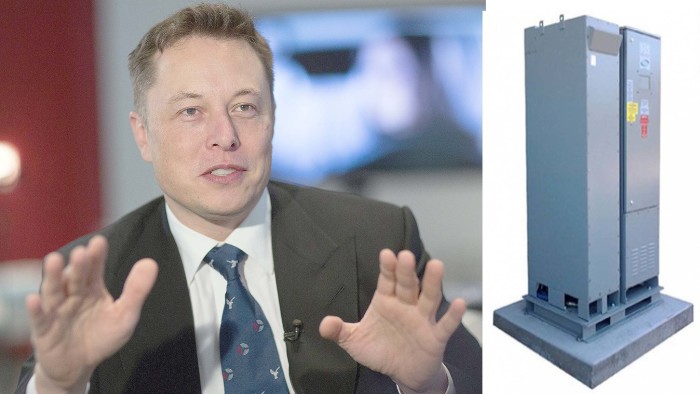Elon Musk’s SolarCity combines solar power with batteries

Roula Khalaf, Editor of the FT, selects her favourite stories in this weekly newsletter.
Elon Musk, the Silicon Valley billionaire, is the man behind the PayPal online payments system, the Tesla luxury electric sports car and SpaceX, the commercial space travel company.
But Mr Musk is also chairman of SolarCity, the biggest installer of residential solar systems in the US, and it has just launched an eye-catching combination of his sprawling interests: battery packs for Tesla cars that store electricity from solar panels.
Figuring out a way to store solar power generated on a sunny day to use when the sun is not shining, or electricity from wind farms to feed back to the grid on a still day, has been a long-sought prize for the renewable energy industry.
Bill Gates, Microsoft co-founder, is one of a number of wealthy investors backing companies trying to solve the problem.
SolarCity’s battery system is not a widely affordable answer yet, analysts say, but it could still help advance important shifts in the way energy is used.
The system is being rolled out first to businesses because it is aimed at cutting a growing energy cost: the charges that utilities impose, not just for the amount of electricity a company uses, but for the level of power it needs at any point in time.
SolarCity says its battery packs can lower these so-called “demand charges” significantly by providing power when demand is highest, as well as providing back-up power during the outages that periodically plague the ageing US electricity grid.
The company is initially offering the system, known as DemandLogic, in places where demand charges are high, such as parts of California, Connecticut and Massachusetts, and hopes eventually to launch a system for households.
“Residential customers have a different use case than major corporate customers since they aren’t hit with demand charges,” said Eric Carlson, senior director of grid integration for SolarCity.
“We are currently piloting our residential storage offering to provide back-up power in the event of a grid outage, and power at night when homeowner’s solar systems aren’t producing energy. We’re offering the pilot in California to several hundred residential customers initially.”
SolarCity says it expects to start installing its first DemandLogic systems for businesses in mid-2014.
The impact of the technology on the broader energy market is not yet clear because of the high price of the lithium-ion batteries it uses, says Sam Jaffe, an analyst at the Navigant research group.
“This kind of product is taking advantage of significant US federal subsidies and because of that, they are able to sell the system at a price point that allows you to do demand charge reduction,” he says.
Still, battery prices are falling fast. Mr Jaffe says smaller lithium batteries, such as those that power laptop computers, now cost $200-$250 per kilowatt hour, compared with $1,200 three years ago, while larger ones used in electric cars are $300-$400 per kWh, half what they were two years ago. “We expect them to get cheaper and cheaper,” he said.
If solar energy storage does spread widely, it is likely to add to the headaches that solar power is posing to conventional utilities around the world.
The plunging cost of solar panels is already turning utility customers into competitors as households start generating their own electricity, especially during daylight hours when utilities have traditionally made the most money.
The big energy generators that still have to build and maintain expensive gas or coal power plants are starting to fight back in many countries, urging regulators to impose fees on people putting in new rooftop solar systems to help pay for the cost of a power grid they say is being used virtually for free.
The conflict is likely to intensify as solar generation continues to surge, and not just in countries such as Germany, the world’s biggest solar power generator.
Growth in the number of residential solar panel installed in the US was so strong in 2013 that it is set to be the first time in more than 15 years that the US has installed more solar generating capacity than Germany, according to forecasts from the GTM research company.
In the third quarter of 2013, the US installed 930 megawatts of solar photovoltaic power – 35 per cent more than the same quarter in 2012.
That is the second largest quarter in the history of the US solar market and the largest quarter ever for residential PV installations, the US Solar Energy Industries Association reported last month.
“Without a doubt, 2013 will go down as a record-shattering year for the US solar industry,” says Rhone Resch, the association’s chief executive. “We’ve now joined Germany, China and Japan as worldwide leaders when it comes to the installation of new solar capacity.”
The US still has some way to go to catch up with the cumulative capacity of Germany, which had more than 32,400MW of solar PV installed at the end of 2012, more than four times as much as the US.
However, that gap is likely to keep shrinking if well-known US companies continue to launch technological advances in areas such as solar energy storage.
“We’re still very much in the infancy of storage,” says MJ Shiao, a solar analyst at GTM Research. “But when you have big companies like SolarCity doing this, it helps move the conversation forward.”
Comments